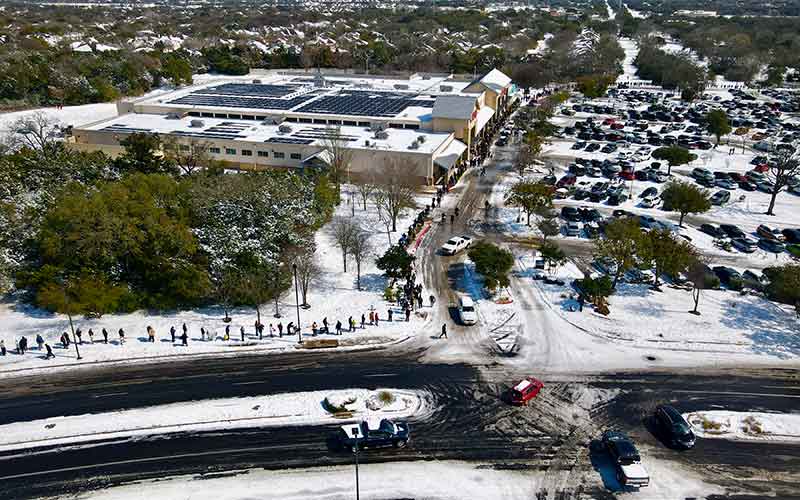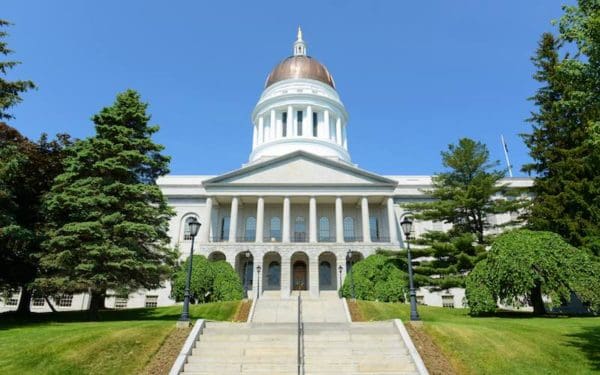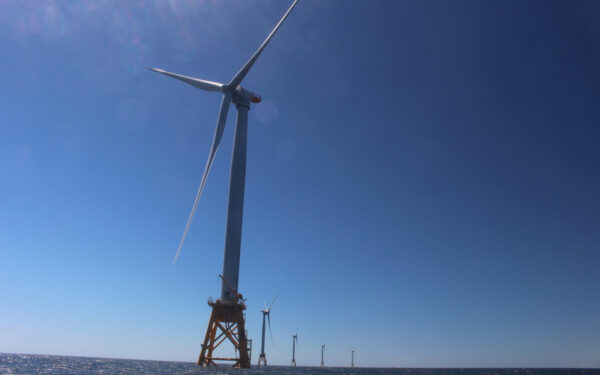
After the power grid failure in Texas, people lined up for hours to find non-perishable food. Photo Credit: Shutterstock
During February’s unusual winter storm, Justin Stanizzi’s Austin apartment lost power. Having grown up in New Hampshire, he wasn’t daunted by the snow forecasts or cold. But what he didn’t know was that Texas was totally unprepared for conditions that would have been just another Monday morning back home.
Over the next few days, things got worse across his neighborhood. Without power, his local cell tower was knocked offline and the nearby hospital had to relocate patients. Temperatures inside his apartment dropped into the 40s, and he had to find clever ways to keep warm. Soon, he found his water shut off, too. Stanizzi felt stunned by the cascade of system failures that left him stranded for days without power or water and with dwindling food supplies.
Millions of people across Texas faced the same untenable situation, one that cost at least 80 lives. Sadly, it could have been avoided had state power generators heeded the lessons from similar winter disasters in years past and taken needed precautions.
New England is no stranger to ice storms, of course, and the Texas power grid is very different from ours. But we can still learn from the Texas crisis – especially as we look at the future pressures our grid will face because of our changing climate.
Why Did the Texas Power Grid Fail?
The Texas grid failed for two primary reasons: It did not build its power sources to withstand cold weather, and its isolated grid can draw only limited power from outside the state. Either of these factors alone would have been problematic last month. Together, they spelled disaster.
Let’s start with the weatherization issue.
Despite more than a decade of warning, Texas’s power generators never made their infrastructure resilient to extreme weather. The result? Sixty percent of their natural gas, coal, and nuclear power froze up and went offline. And yes, some of their wind turbines iced up, too, but they were a much smaller part of the problem.
Texas regulators knew a winter storm could leave the state’s power grid vulnerable, as cold snaps in 1989 and 2011 also triggered devastating blackouts. After 2011, federal and state regulators recommended that utilities upgrade their infrastructure to avoid future failures – insulating power plant pipes and turbines, for example, and increasing reserve power ahead of storms.
But Texas power generators chose not to prepare. Weatherizing costs money, and, in regulation-averse Texas, state leaders did not empower its grid operator (called ERCOT) to require these upgrades. So, power generators ignored the lessons from 2011 and left vulnerable a power grid that millions of people rely on.
Texas’s “Go-It-Alone” Grid Left It Isolated
But even with those failures, the blackouts might not have been so widespread if Texas could draw emergency power from neighboring grid systems. But Texas has deliberately isolated itself, refusing to meaningfully connect its grid to any other outside the state. It did so mainly to avoid federal regulation – the same kind of regulation that could have forced its power generators to make all those upgrades recommended back in 2011.
This isolation also meant that when the state’s primary power producers were forced offline by the record cold temperatures, the grid operator had no backups to draw on to keep the power flowing.
Could This Happen in New England?
Comparing the Texas and New England power grids is apples and oranges for a lot of reasons. However, the issues in Texas do have lessons for us here.
Weather everywhere is already more extreme and erratic – and it’s going to get more so. We must prepare for it. Lives are at stake, and we can’t afford to make mistakes. Regional grid operators – including here in New England – should all be planning ahead to ensure their power systems are resilient and versatile, especially in times of crisis.
And, let’s get this out of the way: Frozen wind turbines were not the problem in Texas and won’t be an issue here. While anti-renewable pundits were quick to blame them, wind and solar have no problem operating in far colder temperatures. There are functional wind turbines as far north as the Arctic Circle, after all. It’s just a matter of being prepared.
New England’s Grid Isn’t Isolated, But That’s Not Good Enough
A critical limitation that all regions must address is inter-regional planning and interconnection. There are nine regional power grid networks across the United States. The New England states form one of these – managed through a regional grid operator called ISO-New England.
Unlike Texas, New England’s grid already connects to those of our neighboring regions and nearby Canadian provinces. However, ISO-New England can do much more to plan transmission and access to power on an inter-regional basis. Such a plan would make power available from adjacent regions in case part of the grid failed. This can ensure that, with help from our neighbors, the lights stay on and heat keeps pumping during weather catastrophes. Resource sharing like this would also help New England avoid the cost of over-building our regional power system to guard against outages.
Carrying out this resource-sharing plan also means upgrading our transmission infrastructure – the lines that ferry power from one region to another. The goal: to make our infrastructure more resilient to climate change’s uncertain impacts and boost the overall power system’s versatility in times of system stress. That upgrade requires regional cooperation and big-picture planning, because, as we’ve just seen in Texas, the costs of inaction are far higher than waiting for the next inevitable disaster to strike.
Clean Energy Is Critical to a Cleaner, More Resilient Future
While upgrading these interconnections is important, local power solutions are equally critical to ensuring our grid’s versatility and resilience. Specifically, we’re talking about solar panels, battery storage, and microgrids spread across communities throughout the region.
Local renewable power adds another element of diversity and resilience to the resources available to keep the lights on. These resources give our homes and businesses independent sources of energy and provide ISO-New England, the grid operator, more sources of electricity any time of the year. They also provide an option to avoid widespread blackouts during an emergency.
On the other hand, if a million people depend on a power plant or transmission line located hundreds of miles away, they’re vulnerable if that plant goes dark or that line gets disrupted along its route. The flexibility to draw from local power sources is critical to making ISO-New England better equipped to face a crisis.
Also, right now, ISO-New England over-relies on dirty fuels like gas. To truly prepare us for the future, our grid operator needs to embrace local and large-scale renewable energy. Wind and solar can – and must – lead the way in our clean energy transformation. In fact, it’s the only way to mitigate even worse climate-induced disasters to come.
We know clean energy can successfully power our electricity grid, lowering pollution and cost in the process. So, having both measures – a strong inter-regional connection to neighboring grids and small and large clean energy sources distributed throughout the region – ensures our system is versatile, flexible, and clean.
What Happens Now?
What happened in Texas was a humanitarian crisis. We must ensure we avoid such a situation here.
Preparing New England’s grid for the future means upgrading our transmission infrastructure. It also means that ISO and our utility companies must look holistically at the power system, factor state policies around clean energy into their planning, and acknowledge that energy is a necessary service. They can’t count on business as usual when climate change impacts are already here. The upfront investments needed are well worth the lives and money saved later on.
We are pushing ISO to follow the states’ vision for a clean, affordable, and reliable 21st-century electric grid. It is critical to keeping our communities safe from the worsening fallout of our climate crisis.




